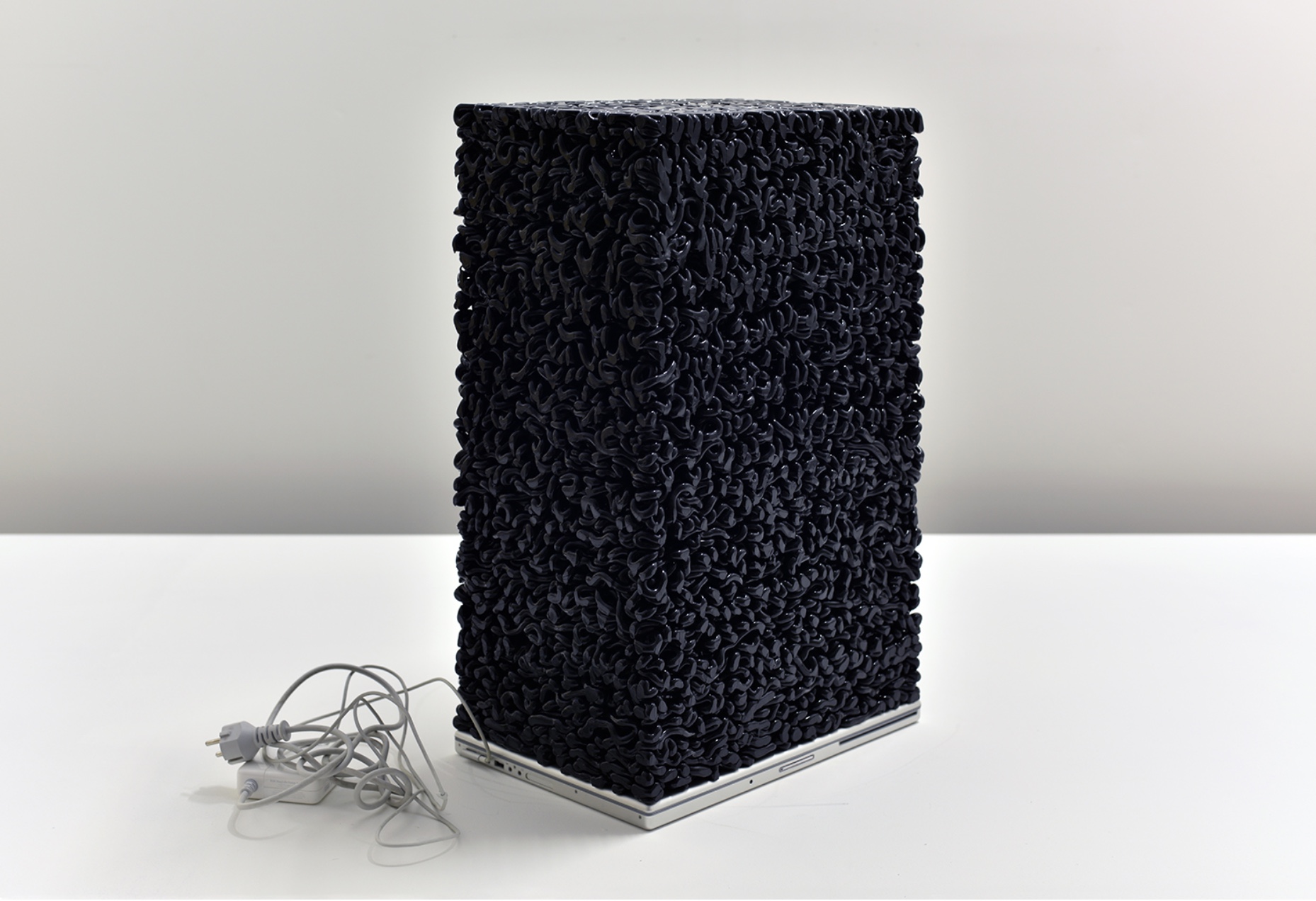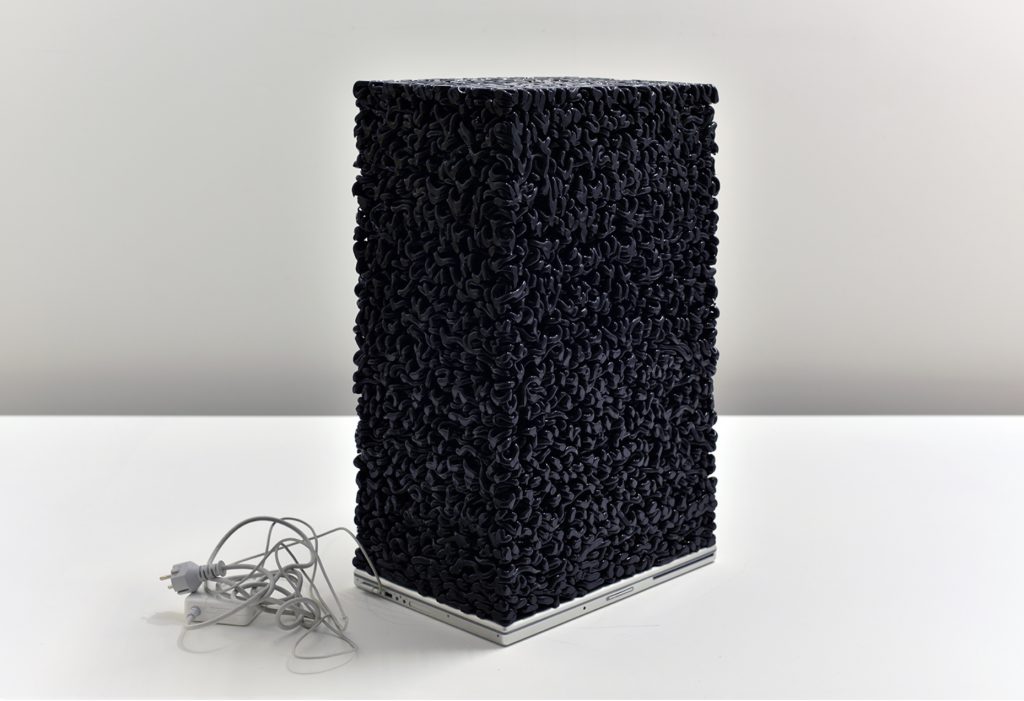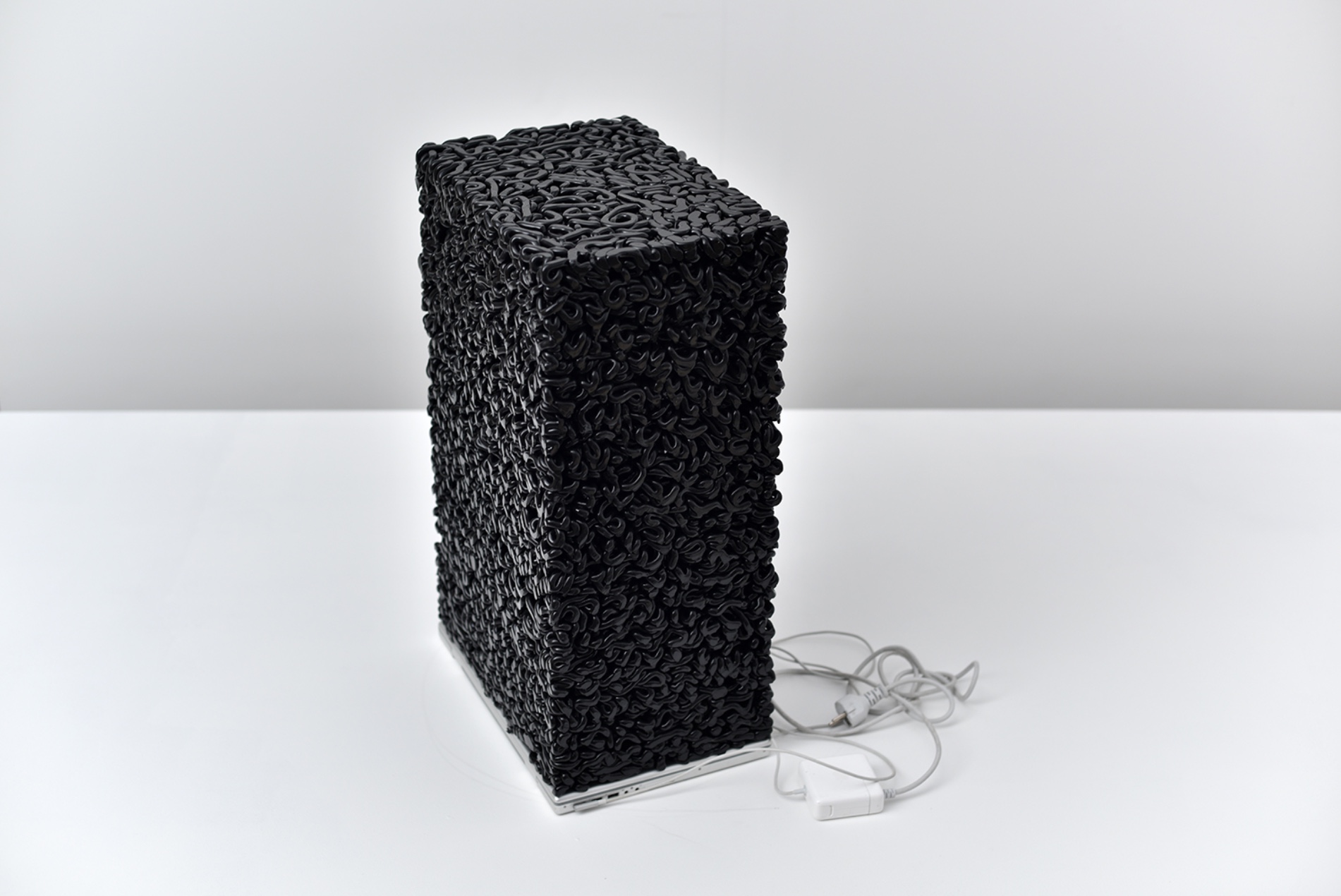A brain in a square – “ein Elektronengehirn” (electronic brain)?
The work of Jonathan Callan on “Dark Matter” started more or less after a visit of my family to Jonathans studio in London in early 2016. I have collected several pieces of Jonathan before, the works that I was particularly interested in deal with the significance of information, data and knowledge, but still they can take a form of an object or a sculpture. Information has many ways of being transported, it can have the shape of books, therefore carbon and paper, or information is condensed without letters in pictures or photographies. Humans have created culture which differentiate them from animals and books is one of these landmarks in cultural evolution. Next to books humans have have mastered to pass on knowledge without just talking about it 1:1 in other forms, starting with large stones or cave drawings as we know. Since Jonathans had used books and photographies quite often, I wondered why Jonathan had yet not the most prominent form yet, with binary code on hard drives. Well, there I believe was no particular reason except that Jonathan had simply to yet had the desire to do so or was not necessarily inspired by it. Since I was utterly fascinated with this form, I suggested to supply my personal data, stored on the hard drive of my laptop and he could use this to whatever he thought was – it was “my book” that had no audience except myself writting on the machine. Jonathan agreed to think about it and then many weeks passed where I heard not much from him. After some time I was wondering wether he was still working on the matter or not. Jonathan had to overcome struggles with his studio as it was flooded after a thunderstorm and not to mention all what debate that lead into “Brexit”; you do not have to be very political to be distracted by this emotional debate. But Jonathan did luckily continue his work; he had some ideas and I was actually almost sure that one approach could be to partially destroy the machine, but he did not think that this was appropriate. I could only encourage to do whatever he thought made sense artistically and that he should not stop himself by the fact that the machine was once valuable to me – a lot of the “data” on that machine “lives on” on my new machine, but that could be part of the artistic concept I thought. Jonathan later told me, it took him time to come up with a concept that made sense. I was hoping for a good result as it was obviously a challenge to come up with a good work, especially if one has not thought of dealing with this matter anyway before. To me sometimes any creative work is “on certain rails”, which means that you have episodes where certain things work out better or do interest you more, so it was no surprise to me that Jonathan could not immediately come up with something that he could associate himself with. Then in late 2016 Jonathan finally called back and presented the piece: “Dark Matter”
Jonathan Callan and myself I believe are both equally happy with the piece – I was almost out of my mind, I really had never expected anything like this piece. But first let’s face the difficulty of the circumstances again: One could definitively say this was a contracted work. Impossible and an immediate personal offence for some artists that I have met before – but luckily not for Jonathan Callan or at least I enjoyed the privilege that he was open for it. I have had some experiences with artists on that matter that were not that pleasing, but this was certainly more than enjoyable. Though I believe feedback and even personal views should or can always be articulated to the artist by anybody, it is up to the artist whether he pays any attention to this. It is quite difficult to say wether the quality of art is undermined when there is a commercial aspect included upfront the work is started. But then on the other hand every piece created by Holbein or Van Eyck was almost always contracted work – so many masterpieces when then only be regarded as an example of craftwork? This makes little sense, it certainly is important that the artist has artistic freedom in the process of creation and being liberated by the later stage of selling it is not automatically a negative aspect. There is a niche of artists who do what they are being told, some do portrays and achieve billings that are incredible by this, so commercially they can call themselves successful. Often this is either a praise of the owner of simply a piece of design or decoration, but it will not stand the test of time. I believe a collector can be involved in the beginning of any work, in the seed stage by being more a less a part of the life of the artist, at least if there is any form of relationship – some simply see collectors as a necessity that pays the bills and this certainly is part of the truth, but must not be everything. However, the creative process that follows initiation should be, in order to be effective, in full control of the artist. Once the artist believes a work has reached completion or is at least close to it to be shown, it is up for discussion again and then the role of the collector is of course to decide whether he would like to add a piece to the collection or not, often depending on what involvement the gallery has. Even museums sometime contract work for their collection and only because this is a public space the work is not always better or representative for the complete work of an artist. Some artists consider consignment work already too much distortion in their thoughts, maybe they would come up with something that is mundane, simply popular but without depth or only appealing to the personal taste of the collector. Since all artistic work is a treatment of the enviroment and influence of real persons I think it is absolutely justified to consider this art of the same quality as any other art work. That the commission follows is certainly a difference to the normal process, but in a positive way it frees the artists from existential concerns of whether the work will find a “home”. It gives the artist ultimately a comfort zone that is called time to come up with a new idea and tackle areas that they may consider risky or not fully in line with their previous ouevre. That some collectors believe that existential struggle is necessary to come up with good work I believe is stupid and not really worth discussing.
When a bigger audience finally sees the piece, everyone can come up with his own view or interpretation of the piece. In this case, my interpretation is heavily influenced by the fact that the data on the laptop is personal – so my interpretation is subjective and cannot be generalized. The Macbook is full of real data, e.g. a CT-Scan of my then unborn daughter Heidi, a picture of my wife and myself, thousands of mails, all documents created in the last 10 years, my life so to speak in CVs and work output, a log of internet files, cookies and I have received and everything else I have created or consumed on this machine in a period of 3-4 years. I believe everyone understands the power a book has, but the difference to a machine like this is, that is also a tool – the most powerful tool of the mind, the “bicycle of the mind” as Steve Jobs once called it, which is for sure a genious marketing term. The quite large block made out of silicon is not only black, it has the shape of the rectangular black block. To me a reference to the black monolith, I immediately recall the Kubricks 2001. Kubricks monolith was such a strong artistic idea especially since its meaning is never revealed and any viewer can come up with his/her own interpretation. The more concepts you have “stored” in your small brain, the more interesting probably your explanation to what the monolith is all about. Some may say it is a higher being, a god or an alien lifeform, so religious context is obvious. But it could also be a device, an antenna or a tool, a machine. Men distinguishes itself mainly to other lifeforms by the ability to have culture and create tools. Both, tools as well as culture are intertwined and so the question is, wether life is always organic and could not also be mechanic or electronic. Thousands of science fiction novels deal with this question (e.g. Philipp Dick “Do Androids dream of electric sheeps?”) and propably the most well known development novel ever written: Pinocchio, where a piece of wood becomes a small puppet that wants to become a real boy. Kubricks idea to come up with a modern Pinocchio resulted in Spielbergs “A.I. Artificial Intelligence”. That movie ends after a new ice ages had begun that is not survived by humans, but evolved “Mechas” live on the planet that created something that is close to a being that has something like a soul. However, today we may be limited to understand wether humans are a breed that will be survived by Androids or simply evolve biologically, but it is fun to come up with different concepts where our species is going, if it ends or if it will transform in a way that we cannot understand or that we fear. Anyhow, all this does not end the speculation on what the dark monolith really means in the odyssee in 2001 and our own odyssee as humans that create culture, tools and artefacts. In Jonathan Callans work the monolith is not made from stone but silicon which is a highly engineered plastic. It is soft and not particularly heavy, the shape of it is almost like human brain. Silicone is not silicon, it is unorganic, it is a keton that is artificial and does not exist in nature although often based on raw oil. A very common observation in our days is that every human uses a smartphone and by its frequent use we are already supporting our natural brain to become a species that is almost like a real cyborg or android, so were are interfacing with a machine all the time. However, today it is not foreseeable wether we can evolve by this or end up sending 140 character tweets and cat pics around the world – something of a sort of masturbation for our brain without any meaningful result for the days after our passing.
“Dark Matter” is a fantastic title as this piece is as well dark, a lot of the data in the machine cannot be accessed any longer with the massive monolith sitting upon it. Data is still on the machine, you can still plug it in and a sound of the BIOS will be heard. I could be reused, maybe it is the last piece that will be left when I have left earth that documents and proves my existence since I have not written books that will remain in a canon (you can have my master thesis if you like). The next reference in the title is to real “dark matter”:
“Dark matter is a hypothetical type of matter distinct from baryonic matter (ordinary matter such as protons and neutrons), neutrinos and dark energy. Dark matter has never been directly observed; however,its existence would explain a number of otherwise puzzling astronomical observations.(…) Although dark matter has not been directly observed, its existence and properties are inferred from its gravitational effects such as the motions of baryonic matter, gravitational lensing, its influence on the universe’s large-scale structure, on the formation of galaxies, and its effects on the cosmic microwave background. The standard model of cosmology indicates that the total mass–energy of the universe contains 4.9% ordinary matter, 26.8% dark matter and 68.3% dark energy. Thus, dark matter constitutes 84.5% of total mass, while dark energy plus dark matter constitute 95.1% of total mass–energy content. The great majority of ordinary matter in the universe is also unseen.” (Wikipedia)
We may see this structure as we see some of the ordinary matter, but we cannot see the content of this machine, what it means and what it does. Also we do not know wether it can be useful or ever was, if it at all had a purpose or if this is irrelevant. The machine once was not only used to access the hard drive, but also connect to the vast ocean of data called the internet. This blog actually was first edited with this machine and its product, the blog stored on other machines can still be accessed. It is almost impossible to kill it or destroy it, it can live on forever as long as energy is supplied to use the data to read and write. The internet as a whole is archived, so even deleting this blog will not make it disappear completely. the conundrum continues: If the machine is supplied with (electric) energy, it can be revived and brought to talk to the user again using machine commando lines. So it is a “underlying feature” of the sculpture, that the machine really is under a block but not dead for all times. As the scultpure is plugged into the grid, it “starts to live”. The machine BIOS boots and the familiar OS sound can be heard. Since the computer is in sleep mode, you can only see the pulsating light diode in the front – just like a sinus curve it goes on to shine and fade on and on. It seems to be like a life function monitor as you can see in this small clip:
“Infinity and beyond” is working in this concept, a machine like this can live a very long life, likely far longer than several human generations if properly stored. Aluminium, silicon and silicone will not be turned into dust for several thousand years. The title and the value of information in “Dark Matter” is just another reference that opens up endless scientific debates that often end in the metaphysical. Our brain is more capable now with the support of machines we can say, our machines are quite powerful compared to what other species have done we know. But wether this amplification is making is more intelligent or if it helps our souls can be questioned. We have extended our machine like capabilities using these machines quite a lot. We do not know what it finally means, what it is good for and whether its existence will have a life after death.In the metaphysical world, neither technology nor culture is of meaning. As we will never know ourselves, how can we be sure about anything? Since this is all evoked by this piece, it is a wonderful example of what contemporary is capable of doing. Obviously I am deeply constituted by all the films I have seen and books I have read. Others come up with a different interpretation, I would be curious to hear one. One reference that I would like to add lies in the early history of mankind. Searching for big stones or creating the large stone sculpture of Stonehenge or Carnac was the creation of almost everlasting landmarks, the first we know of man created purposely. These early humans must have understood that there are always things that will survive them. That this way they have a way to talk to those beings that follow them, not only their ancestors and relatives. Something, that is godlike, everlasting, spiritual and valuable, something that is a multidimensional as the concept of love. So is what we create today, those computers, machines or artificial intelligence of a similar purpose at all or are we totally obsessed with the present, too hectic to understand or even face the question of death and eternity?
As you can imagine it was my pleasure to acquire the work after it was finished and to add it to the collection, where I put in on a pedestal that is enclosed by an acrylic top. I was super happy when I finally received it – it is such a great piece that fits into Jonathan previous work. I am thankful that he put so much effort into it. Could he know how interested I am in this subject? Since we never talked about it I believe not, it is more or less random. That the untold and unexplainable is the most interesting of all things, that it drives anyone to come up with more thoughts and finally get a grasp on it is pure joy, curiosity to understand the inexplicable. Since the matter of “Dark Matter” appeals to everyone at some point in there lifes, I believe this is a significant and fascinating work by Jonathan Callan.


